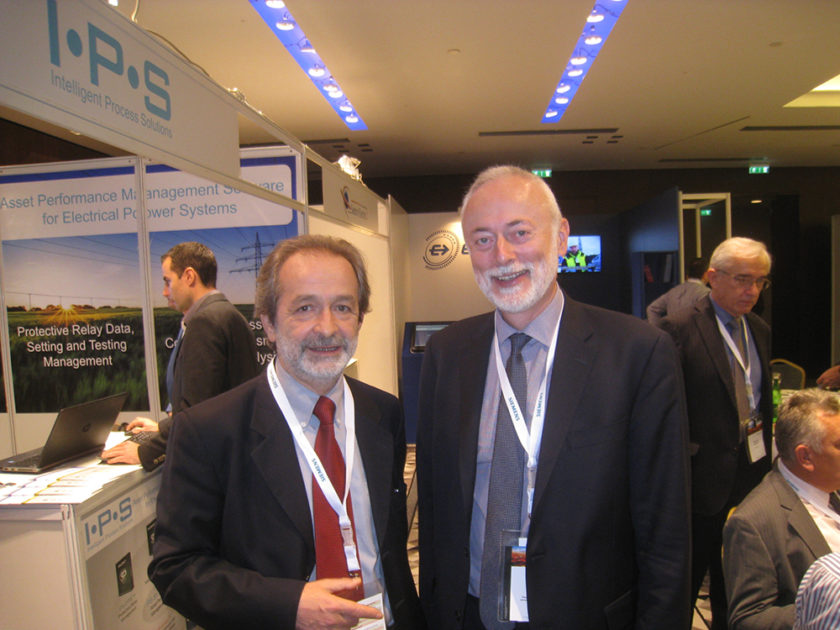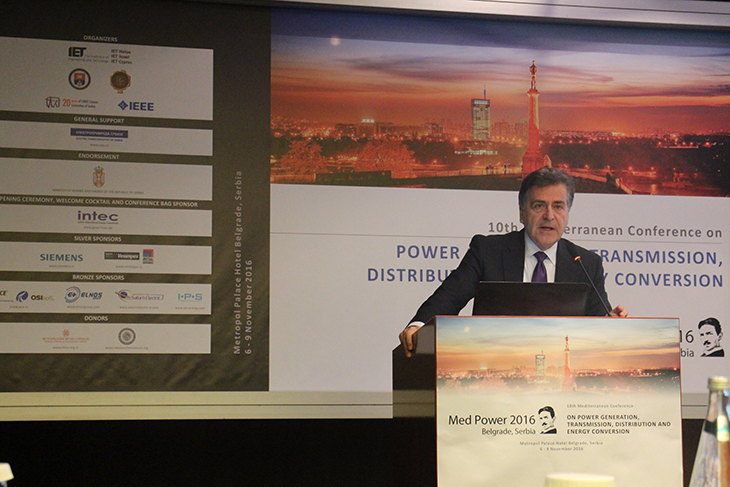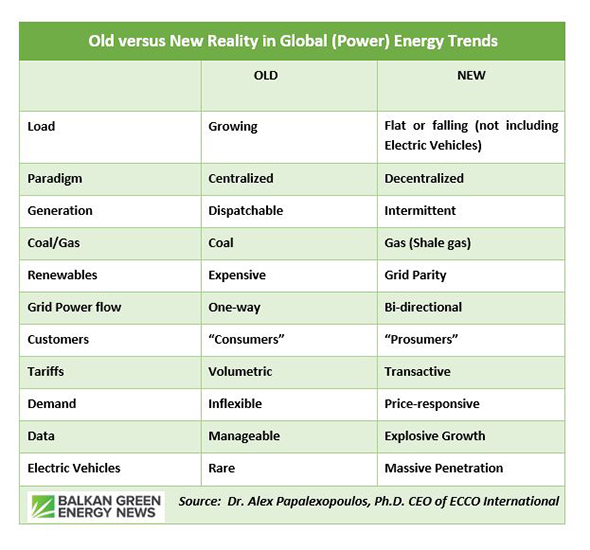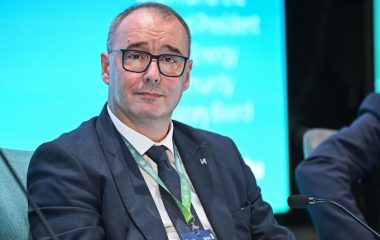
By Mihailo Mihailović, independent energy consultant
Decreasing our dependence on “pre-historic” solar energy stored in fossil fuels and utilizing the “real time” sun power is an inevitable task for Serbia to prepare its future energy mix.
This November Belgrade was the host of the 10th Mediterranean Conference on Power Generation, Transmission, Distribution and Energy Conversion (Med Power 2016). The jubilee conference is organized by the three founding IET Sections (Cyprus, Greece, and Israel), Belgrade University and its School of Electrical Engineering, CIRED Liaison Committee of Serbia and IEEE.
The main objective of the conference is to provide a major forum for state-of-the-art presentations by international experts, give opportunity to engineers and scientists to exchange information and experience and promote international collaboration.
Among 154 submitted papers, 123 have been chosen for the presentation at the Conference. They were grouped in 18 paper sessions, providing high level of R&D and practical experiences of authors from 27 different countries.
Energy is a long-term industry. If you take a decision today, you see results in five to ten years. The cost of renewable energy has continued to fall, civil society is becoming a more active energy player, climate change is acting as a major driver for energy transition and energy has become a crucial issue at the national level, within a context of more complex (interdependent) geopolitics.
In recent years, the Mediterranean region has been affected by different kinds of crises – from war destruction, terrorism and migrations of people, followed by political and economic troubles to extreme weather and natural disasters. Extreme events have increased dramatically, and consequently the food-energy-water nexus is becoming a more pressing issue.
Grand Energy Transition
The world is entering a Grand Energy Transition at an unprecedented speed driven by a combination of factors such as, the transition of decarbonisation, development of new technologies, energy market transformation with system decentralization, digital revolution and shifting consumer expectations. Companies and countries that fail to adapt to new realities put their prosperity at risk.
The most influential part of the conference were introductions of nine invited keynote speakers, world-renown experts who presented the challenging topics. The names of keynote speakers should be given special emphasis: Prof. Miroslav Begović, Ph.D. and Prof. Mladen Kezunović, Ph.D. both from the Texas A&M University, Prof. Jovica Milanović, Ph.D., Prof. Vladimir Terzija, Ph.D. and Prof. Peter Crossley, Ph.D. all three from the University of Manchester, Prof. Nikos Hatziargyriou from NTUA Athens, Mr. Alex Papalexopoulos, Ph.D. ECCO San Francisco, Prof. Slobodan Vukosavic, Ph.D. ETF Belgrade and Prof. Lei Ding, Ph.D. from Shandong University.

Photo 1: Dr. Alex Papalexopoulos, CEO of ECCO International
In his highly interesting presentation, Dr. Alex Papalexopoulos, Ph.D., CEO of ECCO International from San Francisco, USA, pointed out the old versus new reality in global trends transforming the power industry.

Table 1: Old versus new reality in global (power) energy trends
Dr. Alex Papalexopoulos highlighted that the development of organized local energy markets on distribution level and bottom-up approach to energy planning and mapping are essential. Monetizing and penalizing carbon emissions is fundamental to maintaining energy markets, instead of subsidizing all low carbon activities. The transition with implemented environmental goals will require trillion of dollars, not billions.
Gas is the transition fuel; we need to support market structure that values flexibility and capacity; demand response is coming back strong; smart technologies (like IoT – Internet of Things) are emerging.
Photovoltaics in modern power systems
Miroslav M. Begovic, Professor and Head of Electrical and Computer Engineering at the Texas A&M University (on the right on the main photo) prepared a presentation entitled Photovoltaics in Modern Power Systems.
Worldwide consumption of electricity is expected to nearly double over the next two-and-a-half decades. International Energy Agency (IEA) predicts that meeting this demand for power will require over 5,000 GW of new electricity generating capacity (including replacement capacity) at a cost of over USD 5 trillion. The new plants will require an additional USD 6 trillion worth of additional infrastructure, making electric power an USD 11 trillion market over the next 25 years. The search for new generation technologies is accelerating.
IEA Report (2014) predicts Solar Power Domination by 2050. Photovoltaic (PV) could generate as much as 16 percent of the world’s electricity by mid-century. Solar thermal electricity generated by CSP Concentrated Solar Power (CSP) could account for another 11 percent. PV and CSP could cut annual carbon dioxide emissions by more than 6 billion tones with worldwide installation of 4,600 GW of PV capacity by 2050.
Solar is growing rapidly in the United States. US photovoltaic capacity could reach over 50 GW by 2017, which is just over ~2% of US electricity production. The amount of electricity from the other “new” renewable — wind — is currently much larger, almost 5% of the total US electricity.
Thus, the development of storage technologies (mechanical, electrochemical, electric, thermal, chemical) will be helpful for such times when the sun is not shining or the wind is not blowing. On 28 October 2016, the Tesla company unveiled solar roofing (solar tiles), which together with Home-Powerwall-Storage and Tesla electric cars represent a promise of self-sufficiency. In 10 to 15 years, in many parts of the USA, solar-plus battery home systems will be the most economical choice for electric service. Numerous North American utilities are integrating growing numbers of investor-owned photovoltaic distributed generation (PV-DG) plants into their distribution systems.
As the world became more urbanized, given energy-efficient smart grids and technology are more easily applied in cities. Large Cities in Europe produce:
- 80% of EUs GDP,
- 68% of population … 85% by 2050
- 70% of energy consumption,
- 75% of GHG emission
Energy storage
The global energy storage industry is projected to grow exponentially over the next 10 to 15 years. US deployed 41.2 MW of energy storage in the second quarter of 2016, an increase of 126% over the first quarter of the year.
With the Reforming the Energy Vision (REV) initiative, New York is leading in the transition to a more distributed electricity system in which storage will be an essential element. The NY State prepared the NY Roadmap for Energy Storage establishing goals of having 2GW of multi-hour storage capacity on NY electricity grid by 2025 and 4GW by 2030.
The NY State goal of having 50% of generation from renewables by 2030 implies that nearly 30% will likely come from solar and wind (~20% of the state’s generation is from hydroelectric power and several percent from bioenergy).
PJM, the largest US regional transmission operator, in collaboration with AES Energy Storage has added the 64 MW Laurel Mountain energy storage resource in 2011 and the 40 MW Tait resource in 2013. The Laurel Mountain installation is currently the largest battery energy storage system in the United States and one of the largest in the world. In total, with its three AES systems, PJM now has the ability to provide more than 100 MW of variation in less than one second, more than 100 times faster than conventional generators.
Going forward
IEEE (Institute of Electrical and Electronics Engineers) is the world’s largest professional association advancing technology for humanity reaching 420,000+ members from 190 countries, classified in 39 technical societies with approximately 1300+ conferences per year.
Prof. Miroslav Begović is the past president of IEEE PES (Power and Energy Society) with 35,406 official members from all over the world.
Dr. Begović’s research interests are in monitoring, analysis, and control of power systems, as well as development and applications of renewable and sustainable energy systems. He pointed out that academians, energy professionals, bachelors, masters and doctor’s candidates from Serbia have to increase their participation, be more proactive and get communicating benefits from global organizations like IEEE, CIGRE, WEC, IEA, IET, etc. in order to recognize the inevitable energy sector transition. Cheaper solar technology, improved smart grids, advancement in energy storage and rapid digitalization are the major forerunners of the changing dynamics taking place in the PV sector.
Although Serbia has the huge hydropower potential as the leading renewable source for electricity (≈30% of annual production), the fossil fuels (coal) will remain the mainstay electricity provider for decades to come (with actual production of ≈70%). In order to be part of Europe’s climate targets and environmental standards, there is no other way than gradual phasing out coal as a source of energy.
According to the report by the Ministry of Mining and Energy, for the period ending November 2016, Serbia has the operating power generation, utilising “new” renewable energy sources, of 10.4 MW in wind and 8.8 MW in PV installation.
Local power sources, local accumulations and less visible energy efficiency could introduce considerable changes in the way the electricity is produced and consumed.
The Med Power conference held in Belgrade last week, was the high level event for researchers, expert leaders, energy professionals, practitioners and students that provided the newest trends in innovation, technologies development and sensitive environmental challenges for the benefit of all.
Building upon the conference’s conclusions, the only way forward for Serbia is to bring new policy initiatives that would create new framework for sustainable development of energy sector.
For more detailed conference information please visit the official website.


















Be the first one to comment on this article.